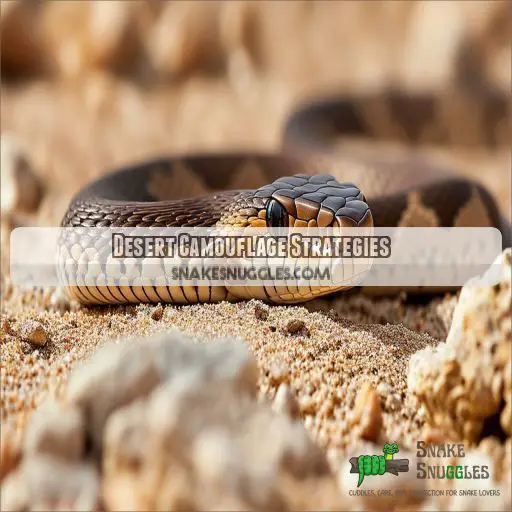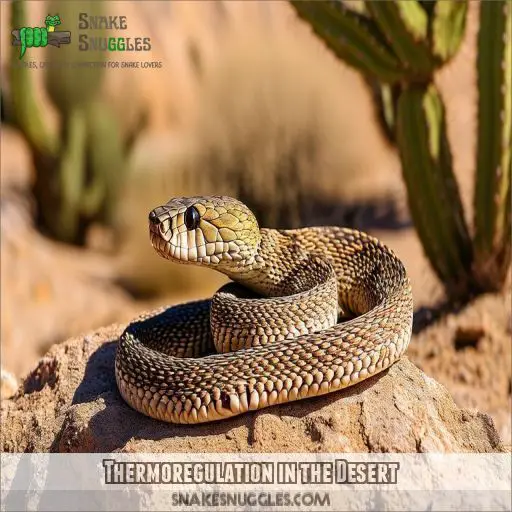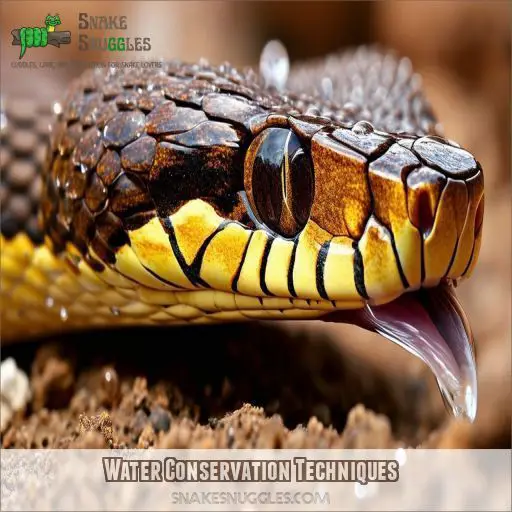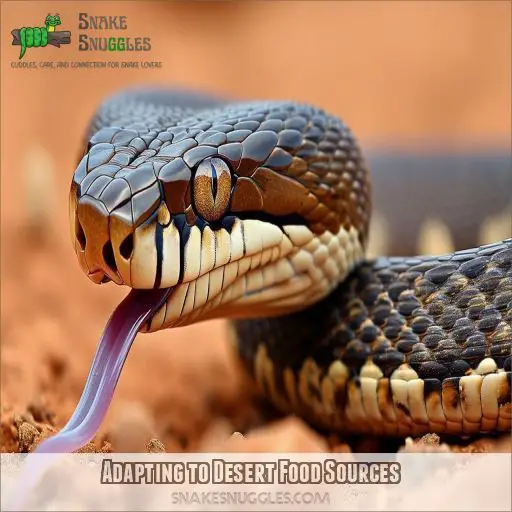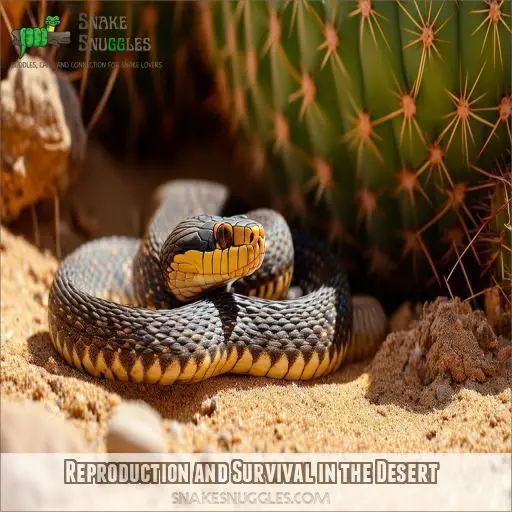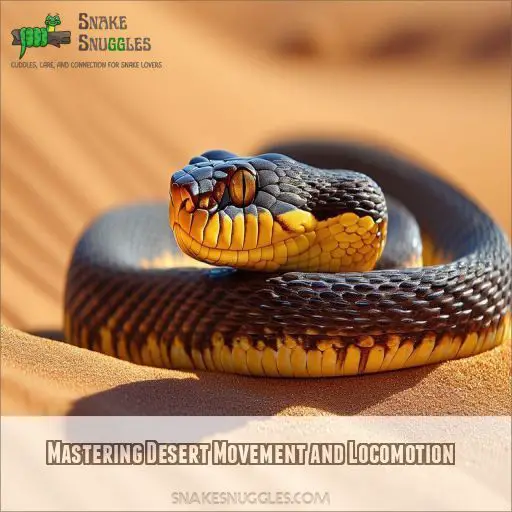This site is supported by our readers. We may earn a commission, at no cost to you, if you purchase through links.
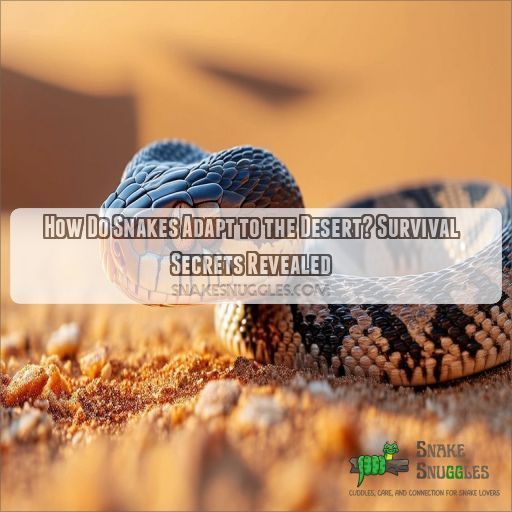 Snakes have a variety of ways to adapt to the desert.
Snakes have a variety of ways to adapt to the desert.
Their light brown or grey scales blend seamlessly with the desert landscape, making them masters of camouflage.
They’re also pros at thermoregulation, staying cool by burrowing into the sand or seeking shade during the day.
Plus, they’re water-wise, getting hydration from their prey and even absorbing water from the air and dew.
With a venomous bite, they can still their desert hunger.
Want to know more about these adaptations?
Table Of Contents
- Key Takeaways
- Desert Camouflage Strategies
- Thermoregulation in the Desert
- Water Conservation Techniques
- Adapting to Desert Food Sources
- Reproduction and Survival in the Desert
- Mastering Desert Movement and Locomotion
- Frequently Asked Questions (FAQs)
- How do snakes adapt to the heat?
- What are 5 adaptations of a snake?
- How snakes adapt to their environment?
- How do reptiles adapt to the desert?
- What do snakes eat in the desert?
- How do snakes survive without much water?
- How do snakes keep cool in the desert?
- Do snakes hibernate in the desert?
- How do snakes move through sand?
- Conclusion
Key Takeaways
- Snakes are masters of disguise, using light-colored scales and stealthy patterns to blend in with the desert landscape.
- They’re smart about temperature control, soaking up the sun when it’s cool and finding shade or burrowing when it’s hot.
- water conservation is key in the desert, and snakes get creative, staying hydrated through their prey and even the air and dew.
- With specialized venom, snakes can paralyze and digest their prey efficiently, making the most of scarce food sources.
Desert Camouflage Strategies
You might be wondering how snakes stay hidden in the vast, open desert. Well, they’ve got some clever tricks up their sleeve, or rather, in their scales. Let’s uncover the secrets of their desert camouflage strategies and how they use them to their advantage.
Blending in With Surroundings
Snakes have a knack for disappearing into their surroundings, and it’s no different in the desert. They’ve got a few tricks up their sleeve, or rather, in their scales, to blend in seamlessly.
You might’ve noticed that desert snakes often rock a light brown or grey look. It’s their way of saying, "Hey, I’m just another sand dune, nothing to see here." This clever coloration fools predators and gives them an edge when ambushing prey.
But it’s not just about the colors; it’s also how they use their scales. Desert snakes are pros at using their scales to mimic the sand and rocks around them. They’re like, "Oh, you thought I was just a pile of rocks? Think again!"
Scale Patterns and Coloration
The patterns on a snake’s scales are like nature’s stealth technology. Some snakes have patterns that break up their outline, making it tough to spot ’em against the sand and rocks. It’s like they’re wearing a desert-camo uniform, helping them stay hidden from predators and giving ’em an edge when they hunt.
Ambushing Prey Effectively
Camouflage is a sneaky survival tactic that helps snakes ambush prey and hide from predators.
With their light brown or grey scales, they blend seamlessly into the desert landscape, like a chameleon.
Their scale patterns also break up their outline, making them even harder to spot.
It’s like they’re invisible!
This clever adaptation gives them the upper hand in hunting and staying safe.
Thermoregulation in the Desert
Snakes are cold-blooded, which means they need to get creative with temperature control. You’ll learn how these slithery creatures keep cool in the desert heat and avoid freezing up when temperatures drop.
Ectothermic Nature of Snakes
Snakes, being ectothermic, rely on external heat sources to regulate their body temperature. This is a key survival strategy in the desert, where temperatures fluctuate. Here’s how they do it:
- Sun-basking: Snakes soak up midday sun during spring and summer, and opt for early morning or late afternoon rays in hotter months.
- Nocturnal heat exchange: At night, snakes keep their cool by exchanging heat with the soil and air.
- Smart activity: Snakes know when to be active, avoiding extreme heat or cold.
Burrowing to Escape Extreme Temperatures
Snakes are pros at adapting to the desert’s wild temperature swings. Their secret? Burrowing into dens for some much-needed R&R. These underground hideouts offer a break from the scorching heat or freezing cold, providing a stable, comfy environment to chill and conserve energy. It’s like nature’s very own thermostat, keeping snakes happy and healthy.
Seeking Shade During Hot Days
Snakes are really smart when it comes to beating the desert heat. They know that hanging out in the sun during the hottest parts of the day isn’t a great idea. So, they do what any sensible creature would do—they find some shade.
These shade-seekers are on to something. By chilling in the shade, they’re avoiding sunburns (snakes can get those too!) and also regulating their body temperature. It’s like they’ve got their own built-in air conditioning.
This behavior is all part of their thermoregulation game. They’re like, "Peace out, sun, I’ve got places to be where it’s cooler."
So, the next time you’re feeling fried in the desert sun, remember the snakes and their clever ways. They’re probably hanging out under a rock or in a burrow, staying cool and waiting for the sun to go down.
Water Conservation Techniques
Water is scarce in the desert, and snakes have evolved clever ways to stay hydrated. They get most of their water from their prey and have adapted to need very little water, which is essential for their survival.
Obtaining Water From Prey
Snakes don’t need to drink water like we do. They’re smart about it and get most of their hydration from their prey. These desert animals, like rodents and lizards, provide a tasty water source. It’s like a two-for-one deal for snakes—a meal and a drink all in one!
Absorbing Water From Air and Dew
Apart from their meals, some desert snakes can absorb water from the air and dew. They’re pros at water conservation, and their skin helps them soak up dew that forms at night.
Reducing Activity During Hot Days
Snakes adapt to the desert climate by reducing their activity during the hottest parts of the day. This strategy helps them conserve water and energy, allowing them to survive in harsh conditions.
Conserving Water Through Skin Absorption
Did you know some snakes can absorb water through their skin? That’s right! These sneaky serpents can soak up the dew that forms at night, keeping themselves hydrated in the arid desert conditions. Nature, huh?
Adapting to Desert Food Sources
Snakes are picky eaters in the desert, favoring a diet of rodents, lizards, and insects. They also enjoy eggs and smaller animals as tasty treats. To catch their prey, they use their venom to paralyze and start digesting it, making mealtime a breeze.
Primary Prey in the Desert
So, what do snakes eat in the desert? Their primary prey includes rodents, lizards, and insects. They might also snack on eggs or smaller animals. It’s a snake’s buffet out there!
Using Venom for Subduing Prey
When it comes to getting a meal, desert snakes have a secret weapon: their venom. Here’s how they use it to their advantage:
- Paralyzing prey: With a quick strike, they inject venom that immobilizes their target, making it easier to catch and consume.
- Aiding digestion: Venom isn’t just for the hunt; it also helps break down food. This is especially useful when water is scarce, as it reduces the need for water during digestion.
- Efficiency boost: By paralyzing and pre-digesting their prey, snakes can make the most of their catch. This efficiency means they get the nutrients they need with minimal effort, a key advantage in the desert.
- Specialized diets: Some snakes have evolved to target specific prey, with venom designed to subdue their preferred food sources.
- Toxicity variation: Different snake species have varying levels of toxicity in their venom, showcasing the adaptability of these reptiles.
Specialized Diets of Desert Snakes
Desert snakes have evolved to adapt to the limited food sources available in their harsh environment. They primarily feed on rodents, lizards, and insects, but may also consume eggs and other small animals.
| Desert Snake | Specialized Diet |
|---|---|
| Rattlesnake | Rodents |
Some species, like the rattlesnake, have developed a preference for certain prey items, such as rodents, which are abundant in desert habitats. This specialization allows them to efficiently utilize the resources available and thrive in their arid environment.
Importance of Venom in Digestion
Venom is a snake’s secret weapon, helping with both prey capture and digestion. It’s like a built-in superpower that makes sure they can efficiently turn their meals into much-needed energy.
Reproduction and Survival in the Desert
Reproduction is key to survival, and snakes have some unique ways to make sure their young thrive in the desert. From laying eggs in secret spots to the challenges hatchlings face, let’s explore how these reptiles keep their genes going in such a harsh environment.
Laying Eggs in Sheltered Locations
Desert snakes, like most reptiles, reproduce by laying eggs. But they’re not gonna leave their eggs just anywhere. These snakes carefully choose sheltered locations, such as under rocks or in burrows, to keep their eggs safe.
Incubation and Hatching Processes
Desert snakes don’t babysit their eggs. They lay their eggs in sheltered spots, like under rocks or in burrows, and then the eggs are left to incubate and hatch on their own. But that’s not all – these snakes may also lay multiple clutches of eggs each year. Talk about a productive bunch!
- Sheltered spots for eggs
- Independent incubation and hatching
- Multiple clutches per year
- Hatchlings ready to face the desert
Independent Hatchlings and Their Survival
The moment these hatchlings crack open their eggs, they’re on their own. No time for snuggling up to mom or dad—they gotta find food and shelter ASAP. It’s a tough world out there for these tiny snakes, but they’re born survivors.
Multiple Clutches of Eggs Per Year
Snakes are resilient, adapting their reproduction to the harsh desert environment. They may lay multiple clutches of eggs per year, boosting their survival chances in challenging conditions.
Mastering Desert Movement and Locomotion
Snakes have evolved some pretty impressive ways to move across the desert. In this section, we’ll uncover the unique locomotion styles of sidewinders and explore how they adapt to moving through loose sand. We’ll also look into the physical adaptations that enable efficient breathing and movement in this challenging environment.
Unique Locomotion Styles of Sidewinders
Sidewinders have a unique style of locomotion, making them masters of desert movement. They move by making contact with the sand at only two points, allowing them to lurch quickly sideways.
Adaptations for Moving in Loose Sand
Snakes have a variety of physical adaptations that help them move efficiently through loose sand. Here are some of the ways they’ve mastered this challenging terrain:
- Two-Point Contact: Sidewinders, for example, make contact with the sand at only two points, allowing them to lurch sideways quickly. This unique style of locomotion helps them navigate shifting sands.
- Smooth Scales: Some species have smooth scales that aid in moving through the sand without creating friction or getting stuck.
- Narrow Heads and Small Eyes: These physical traits help snakes move through tight spaces and reduce the amount of sand that gets in their eyes.
Efficient Breathing and Movement in Sand
To survive in the desert, snakes have evolved efficient breathing and movement strategies. They navigate loose sand with ease, thanks to adaptations like smooth scales, narrow heads, small eyes, and countersunk lower jaws. These features help snakes breathe efficiently and move seamlessly through their sandy habitat.
| Snake Species | Breathing Adaptations | Movement Adaptations |
|---|---|---|
| Sidewinder | Two-point contact with sand | Quick sideways lurching |
| Flat-tailed horned lizard | Lack of external ear openings | |
| Baja California legless lizard | Lack of external ear openings |
Importance of Specialized Movement in Desert Survival
Sidewinders have a unique movement style, making contact with the sand at only two points. This helps them navigate the desert’s shifting sands.
Here are 3 key points about this fascinating adaptation:
- Two-Point Contact: Sidewinders lunge sideways, only touching the sand with two points of their body at a time.
- Efficient Locomotion: This movement style allows them to move quickly and efficiently across loose sand.
- Survival Advantage: By adapting to the desert environment, sidewinders gain an edge in escaping predators and capturing prey.
Frequently Asked Questions (FAQs)
How do snakes adapt to the heat?
Snakes adapt to the heat by being active at the best times to avoid extreme temperatures. They may bask in the sun, choosing midday, or opt for shade during the hottest parts of the day.
What are 5 adaptations of a snake?
Snakes have a bag of tricks to survive the desert’s harsh conditions. Here are five adaptations that help them beat the heat:
- Thermoregulation: Snakes bask in the sun when it’s warm and burrow underground or seek shade when it’s too hot.
- Water Conservation: They get water from their prey and can go long periods without eating or drinking.
- Camouflage: Their light brown or grey scales help them blend into the sand and rocks, keeping them hidden from predators.
- Specialized Movement: Some snakes, like sidewinders, have a unique side-winding locomotion that helps them move across loose sand.
- Hunting and Defence: Venom helps snakes paralyze and digest prey, and their coloration provides an advantage when hunting or avoiding predators.
How snakes adapt to their environment?
Snakes adapt to their environment with thermoregulation, water conservation, camouflage, and specialized movement. They’re cold-blooded, so they rely on their surroundings to stay comfy.
How do reptiles adapt to the desert?
Reptiles are survivors, evolving from their amphibious ancestors to conquer arid lands. They’re like chameleons, adapting to the desert’s harsh conditions with smart water conservation, burrowing, and unique egg shells.
What do snakes eat in the desert?
Desert snakes are carnivores, dining on a diet of rodents, lizards, birds, smaller snakes, and frogs. They also eat the eggs of the animals they prey on.
How do snakes survive without much water?
Snakes survive in arid conditions by getting most of their water from their prey and the environment. They don’t need to eat daily, conserving energy and reducing water needs. This water management is key to their desert survival.
How do snakes keep cool in the desert?
Snakes keep cool in the desert by burrowing, seeking shade, and reducing activity during the day. They also adapt by exchanging heat with the soil and air at night.
Do snakes hibernate in the desert?
Don’t worry about rattlesnakes in winter—they’re hibernating. But what about summer? Snakes don’t hibernate when it’s hot, right? Wrong! Snakes in hot places like Arizona aestivate, burrowing during the hottest weeks.
How do snakes move through sand?
Snakes have developed a unique way of moving through sand. Sidewinders, for example, touch the sand at only two points, allowing them to quickly lurch sideways.
Conclusion
Snakes have evolved a diverse toolkit to thrive in harsh desert conditions.
From clever camouflage to water-saving strategies, these reptiles are experts at surviving where others might struggle.
You’ve now got the inside scoop on how snakes adapt to the desert, from staying cool and hydrated to finding food and reproducing.

